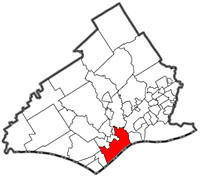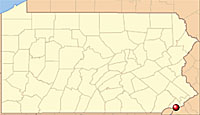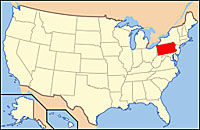Chester has recently been working towards becoming a business hub. Recent development has been focused on the waterfront, once a booming industrial area. To encourage redevelopment, the area has been declared a Keystone Opportunity Zone, or KOZ, where new businesses would be exempt for the most part from all state and local taxes through 2013. One developments taking advantage is The Wharf at Rivertown, a $60 million renovation of the former Philadelphia Electric Company‘s 396,000 square foot generating plant, which was originally built in Chester in 1918, and now providing both recreational and office space for new local endeavors.
Other businesses taking advantage of KOZ include AdminServer, an upstart insurance software solution company that has drawn the market’s attention. Sun Shipbuilding, which had large presence on the water front in the past, sold off portions of the rest to new users, such as the Pennsylvania State Correctional Institution Chester. Harrah’s Casino and Racetrack built its facilities beginning in 2005, launching harness racing along the Delaware River in September 2006, and its racino in January 2007.
Redevelopment of the Waterfront brought other proposed changes as well. State Route 291 is currently under construction to expand the road, incl;using plans to start construction of new exit and entrance ramps from the bridge to Rt. 291, providing an alternate route to the waterfront.
This influx of KOZ development brought businesses into Chester, but the benefit for the local community is controversial. Opinions differ on how many jobs were created by the new businesses when compared to promises. Tax exemptions have impacted the public education system of Chester because no new tax revenue for the schools has been created from these new developments. As tax exemptions expire in just about two years there will be a new shift in the impact of this initiative because new tax revenue will be received despite the delay. Also, proposed rerouting of State Route 291 would enable people heading to destinations on the Waterfront to avoid most of downtown and residential Chester, excluding local businesses from the increased consumer traffic that the development was intended to create.
Tax incentives are a large part of Chester’s economic revitalization plan. While KOZ focuses on a underdeveloped or distressed area farther outside of the main part of Chester, the Local Economic Revitalization Tax Assistance Act, orLERTA, focuses on deteriorating properties in other parts of the city. LERTA allows businesses to expand or construct new facilities and defer the increase in real estate tax for 10 years. The real estate tax increase will be phased in at a rate of 10% a year.
In addition to these larger scale tax incentives, there are small scale business loans and other programs in Chester. The small business loan program makes $5000-$100000 available for businesses creating or retaining employment for low to moderate income persons. The loan has a fixed 3% interest rate and will cover 50% of the project cost. For each $25,000 of the loan one full time job must be created, in hopes of establishing small businesses in Chester alongside the larger scale businesses.
Attracting businesses for economic development is only part of the plan. There are also programs to help existing businesses make their building more appealing, in order to help with the overall image of Chester. The Façade Improvement Program for businesses in the downtown business district lends up to $10,000.
PPL Park, home of the Philadelphia Union Major League Soccer team, is another big business venture in Chester. The development includes over 200 new residential units, over 22,000 square feet of retail space, 335,000 square feet of office space, a 200,000 square foot exhibition center and a 1,350 space parking garage.
More info:
http://www.nytimes.com/2006/02/15/realestate/commercial/15chester.html
http://www.ceda.cc/assets/pdf/FAR1KOZCOCMap.pdf


